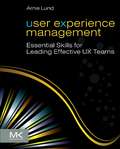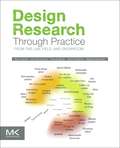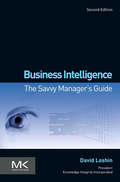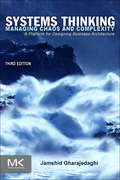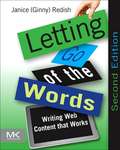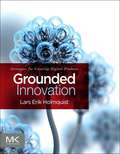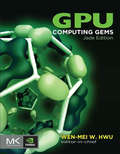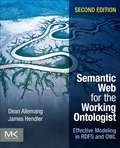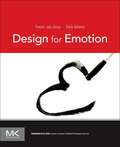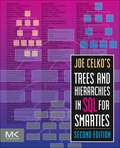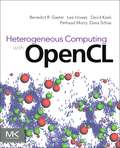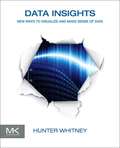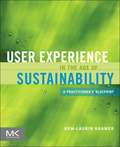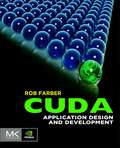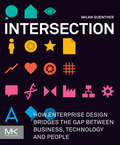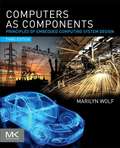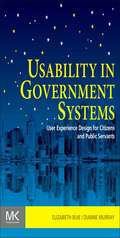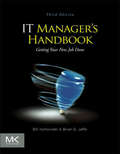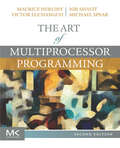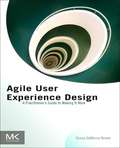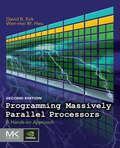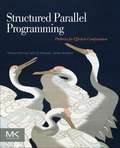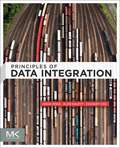- Table View
- List View
User Experience Management: Essential Skills for Leading Effective UX Teams
by Arnie LundUser Experience Management: Essential Skills for Leading Effective UX Teams deals with specific issues associated with managing diverse user experience (UX) skills, often in corporations with a largely engineering culture. Part memoir and part handbook, it explains what it means to lead a UX team and examines the management issues of hiring, inheriting, terminating, layoffs, interviewing and candidacy, and downsizing. The book offers guidance on building and creating a UX team, as well as equipping and focusing the team. It also considers ways of nurturing the team, from coaching and performance reviews to conflict management and creating work-life balance. Furthermore, it discusses the essential skills needed in leading an effective team and developing a communication plan. This book will be valuable to new managers and leaders, more experienced managers, and anyone who is leading or managing UX groups or who is interested in assuming a leadership role in the future.Gives a UX leadership boot-camp from putting together a winning team, to giving them a driving focus, to acting as their spokesman, to handling difficult situationsFull of practical advice and experiences for managers and leaders in virtually any area of the user experience fieldContains best practices, real-world stories, and insights from UX leaders at IBM, Microsoft, SAP, and many more!
Design Research Through Practice: From the Lab, Field, and Showroom
by Thomas Binder Ilpo Koskinen Johan Redstrom John Zimmerman Stephan WensveenDesign Research Through Practice: From the Lab, Field, and Showroom focuses on one type of contemporary design research known as constructive design research. It looks at three approaches to constructive design research: Lab, Field, and Showroom. The book shows how theory, research practice, and the social environment create commonalities between these approaches. It illustrates how one can successfully integrate design and research based on work carried out in industrial design and interaction design. The book begins with an overview of the rise of constructive design research, as well as constructive research programs and methodologies. It then describes the logic of studying design in the laboratory, design ethnography and field work, and the origins of the Showroom and its foundation on art and design rather than on science or the social sciences. It also discusses the theoretical background of constructive design research, along with modeling and prototyping of design items. Finally, it considers recent work in Lab that focuses on action and the body instead of thinking and knowing. Many kinds of designers and people interested in design will find this book extremely helpful. Gathers design research experts from traditional lab science, social science, art, industrial design, UX and HCI to lend tested practices and how they can be used in a variety of design projectsProvides a multidisciplinary story of the whole design process, with proven and teachable techniques that can solve both academic and practical problemsPresents key examples illustrating how research is applied and vignettes summarizing the key how-to details of specific projects
Business Intelligence: The Savvy Manager's Guide (The Morgan Kaufmann Series on Business Intelligence)
by David LoshinBusiness Intelligence: The Savvy Managers Guide, Second Edition, discusses the objectives and practices for designing and deploying a business intelligence (BI) program. It looks at the basics of a BI program, from the value of information and the mechanics of planning for success to data model infrastructure, data preparation, data analysis, integration, knowledge discovery, and the actual use of discovered knowledge. Organized into 21 chapters, this book begins with an overview of the kind of knowledge that can be exposed and exploited through the use of BI. It then proceeds with a discussion of information use in the context of how value is created within an organization, how BI can improve the ways of doing business, and organizational preparedness for exploiting the results of a BI program. It also looks at some of the critical factors to be taken into account in the planning and execution of a successful BI program. In addition, the reader is introduced to considerations for developing the BI roadmap, the platforms for analysis such as data warehouses, and the concepts of business metadata. Other chapters focus on data preparation and data discovery, the business rules approach, and data mining techniques and predictive analytics. Finally, emerging technologies such as text analytics and sentiment analysis are considered. This book will be valuable to data management and BI professionals, including senior and middle-level managers, Chief Information Officers and Chief Data Officers, senior business executives and business staff members, database or software engineers, and business analysts. Guides managers through developing, administering, or simply understanding business intelligence technologyKeeps pace with the changes in best practices, tools, methods and processes used to transform an organization’s data into actionable knowledgeContains a handy, quick-reference to technologies and terminology
Systems Thinking: Managing Chaos and Complexity: A Platform for Designing Business Architecture
by Jamshid GharajedaghiSystems Thinking, Third Edition combines systems theory and interactive design to provide an operational methodology for defining problems and designing solutions in an environment increasingly characterized by chaos and complexity. This new edition has been updated to include all new chapters on self-organizing systems as well as holistic, operational, and design thinking. The book covers recent crises in financial systems and job markets, the housing bubble, and environment, assessing their impact on systems thinking. A companion website is available at interactdesign.com. This volume is ideal for senior executives as well as for chief information/operating officers and other executives charged with systems management and process improvement. It may also be a helpful resource for IT/MBA students and academics. Four NEW chapters on self-organizing systems, holistic thinking, operational thinking, and design thinkingCovers the recent crises in financial systems and job markets globally, the housing bubble, and the environment, assessing their impact on systems thinkingCompanion website to accompany the book is available at interactdesign.com
Letting Go of the Words: Writing Web Content that Works (Interactive Technologies)
by Janice (Ginny) RedishWeb site design and development continues to become more sophisticated. An important part of this maturity originates with well-laid-out and well-written content. Ginny Redish is a world-renowned expert on information design and how to produce clear writing in plain language for the web. All of the invaluable information that she shared in the first edition is included with numerous new examples. New information on content strategy for web sites, search engine optimization (SEO), and social media make this once again the only book you need to own to optimize your writing for the web.New material on content strategy, search engine optimization, and social mediaLots of new and updated examplesMore emphasis on new hardware like tablets, iPads, and iPhones
Grounded Innovation: Strategies for Creating Digital Products
by Lars Erik HolmquistGrounded Innovation: Strategies for Creating Digital Products focuses on the innovation processes and technical properties of digital products. Drawing on case studies, the book looks at systematic ways to ground innovation in both technology and human needs, and it explores how digital products have become integrated in the real world. It provides guidelines to innovation in a new technical environment, including prototyping and testing, within the cultural or financial parameters of a business. The book is divided into two parts. Part 1 discusses the history and the basic properties of digital products; the different approaches to innovation; the concept of grounded innovation; and concepts and processes that are important for creating successful innovations such as inquiry, invention, and prototyping. Part 2 demonstrates how the basic properties of digital products can be used as raw material for new innovations, including interaction, networking, sensing, and proactivity. There is also a discussion on recent technology, such as rapid prototyping and mobile mash-ups. A wide variety of examples show how novel technical and conceptual innovations became commercial breakthroughs. Grounded Innovation is ideal for product designers, interaction designers, and design-oriented engineers. It will also be a valuable resource for anyone interested in understanding how digital products are created and in a general approach to information technology. Wide variety of examples show how novel technical and conceptual innovations became commercial breakthroughsProvides guidelines to innovation in a new technical environment including prototyping and testingDiscusses how to innovate within the cultural or financial parameters of a business
GPU Computing Gems Jade Edition (Applications of GPU Computing Series)
by Wen-mei W. HwuGPU Computing Gems, Jade Edition, offers hands-on, proven techniques for general purpose GPU programming based on the successful application experiences of leading researchers and developers. One of few resources available that distills the best practices of the community of CUDA programmers, this second edition contains 100% new material of interest across industry, including finance, medicine, imaging, engineering, gaming, environmental science, and green computing. It covers new tools and frameworks for productive GPU computing application development and provides immediate benefit to researchers developing improved programming environments for GPUs. Divided into five sections, this book explains how GPU execution is achieved with algorithm implementation techniques and approaches to data structure layout. More specifically, it considers three general requirements: high level of parallelism, coherent memory access by threads within warps, and coherent control flow within warps. Chapters explore topics such as accelerating database searches; how to leverage the Fermi GPU architecture to further accelerate prefix operations; and GPU implementation of hash tables. There are also discussions on the state of GPU computing in interactive physics and artificial intelligence; programming tools and techniques for GPU computing; and the edge and node parallelism approach for computing graph centrality metrics. In addition, the book proposes an alternative approach that balances computation regardless of node degree variance. Software engineers, programmers, hardware engineers, and advanced students will find this book extremely usefull. For useful source codes discussed throughout the book, the editors invite readers to the following website: …"This second volume of GPU Computing Gems offers 100% new material of interest across industry, including finance, medicine, imaging, engineering, gaming, environmental science, green computing, and more Covers new tools and frameworks for productive GPU computing application development and offers immediate benefit to researchers developing improved programming environments for GPUsEven more hands-on, proven techniques demonstrating how general purpose GPU computing is changing scientific research Distills the best practices of the community of CUDA programmers; each chapter provides insights and ideas as well as 'hands on' skills applicable to a variety of fields
Semantic Web for the Working Ontologist: Effective Modeling in RDFS and OWL (Acm Bks.)
by James Hendler Dean AllemangSemantic Web for the Working Ontologist: Effective Modeling in RDFS and OWL, Second Edition, discusses the capabilities of Semantic Web modeling languages, such as RDFS (Resource Description Framework Schema) and OWL (Web Ontology Language). Organized into 16 chapters, the book provides examples to illustrate the use of Semantic Web technologies in solving common modeling problems. It uses the life and works of William Shakespeare to demonstrate some of the most basic capabilities of the Semantic Web. The book first provides an overview of the Semantic Web and aspects of the Web. It then discusses semantic modeling and how it can support the development from chaotic information gathering to one characterized by information sharing, cooperation, and collaboration. It also explains the use of RDF to implement the Semantic Web by allowing information to be distributed over the Web, along with the use of SPARQL to access RDF data. Moreover, the reader is introduced to components that make up a Semantic Web deployment and how they fit together, the concept of inferencing in the Semantic Web, and how RDFS differs from other schema languages. Finally, the book considers the use of SKOS (Simple Knowledge Organization System) to manage vocabularies by taking advantage of the inferencing structure of RDFS-Plus. This book is intended for the working ontologist who is trying to create a domain model on the Semantic Web.Updated with the latest developments and advances in Semantic Web technologies for organizing, querying, and processing information, including SPARQL, RDF and RDFS, OWL 2.0, and SKOS Detailed information on the ontologies used in today's key web applications, including ecommerce, social networking, data mining, using government data, and more Even more illustrative examples and case studies that demonstrate what semantic technologies are and how they work together to solve real-world problems
Design for Emotion
by Trevor van Gorp Edie AdamsDesign for Emotion introduces you to the why, what, when, where and how of designing for emotion. Improve user connection, satisfaction and loyalty by incorporating emotion and personality into your design process. The conscious and unconscious origins of emotions are explained, while real-world examples show how the design you create affects the emotions of your users. This isn’t just another design theory book – it’s imminently practical. Design for Emotion introduces the A.C.T. Model (Attract/Converse/Transact) a tool for helping designers create designs that intentionally trigger emotional responses. This book offers a way to harness emotions for improving the design of products, interfaces and applications while also enhancing learning and information processing. Design for Emotion will help your designs grab attention and communicate your message more powerfully, to more people. Explains the relationship between emotions and product personalitiesDetails the most important dimensions of a product's personalityExamines models for understanding users' relationships with productsExplores how to intentionally design product personalities Provides extensive examples from the worlds of product, web and application designIncludes a simple and effective model for creating more emotional designs
OCEB Certification Guide: Business Process Management - Fundamental Level
by Tim WeilkiensOCEB Certification Guide delivers expert insight into BPM from one of the developers of the OCEB Fundamental exam, offering full coverage of the exam material for both the business and technical tracks. The first study guide to prepare candidates to take and pass the OCEB Fundamental exam, it explains and builds on basic concepts, focusing on key areas and testing knowledge of all critical topics with sample questions and detailed answers. Suitable for practitioners and those newer to the field, this book provides a solid grounding in business process management based on the authors’ own extensive BPM consulting experience. Covers all of the topics on the Fundamentals exam, eliminating hours otherwise spent in research and prep time Includes sample test questions in each chapter with all answers in the appendix Expert authors provide a solid overview of business process management (BPM)
Joe Celko's Trees and Hierarchies in SQL for Smarties (The Morgan Kaufmann Series in Data Management Systems)
by Joe CelkoThe demand for SQL information and training continues to grow with the need for a database behind every website capable of offering web-based information queries. SQL is the de facto standard for database retrieval, and if you need to access, update, or utilize data in a modern database management system, you will need SQL to do it. The Second Edition of Joe Celko's Trees and Hierarchies in SQL for Smarties covers two new sets of extensions over three entirely new chapters and expounds upon the changes that have occurred in SQL standards since the previous edition's publication. Benefit from mastering the challenging aspects of these database applications in SQL as taught by Joe Celko, one of the most-read SQL authors in the world.Expert advice from a noted SQL authority and award-winning columnist who has given 10 years of service to the ANSI SQL standards committeeTeaches scores of advanced techniques that can be used with any product, in any SQL environmentOffers graph theory and programming techniques for working around deficiencies and gives insight into real-world challenges
Heterogeneous Computing with OpenCL: Revised Opencl 1. 2 Edition
by David R. Kaeli Perhaad Mistry Dana Schaa Benedict Gaster Lee HowesHeterogeneous Computing with OpenCL teaches OpenCL and parallel programming for complex systems that may include a variety of device architectures: multi-core CPUs, GPUs, and fully-integrated Accelerated Processing Units (APUs) such as AMD Fusion technology. Designed to work on multiple platforms and with wide industry support, OpenCL will help you more effectively program for a heterogeneous future. Written by leaders in the parallel computing and OpenCL communities, this book will give you hands-on OpenCL experience to address a range of fundamental parallel algorithms. The authors explore memory spaces, optimization techniques, graphics interoperability, extensions, and debugging and profiling. Intended to support a parallel programming course, Heterogeneous Computing with OpenCL includes detailed examples throughout, plus additional online exercises and other supporting materials.Explains principles and strategies to learn parallel programming with OpenCL, from understanding the four abstraction models to thoroughly testing and debugging complete applications.Covers image processing, web plugins, particle simulations, video editing, performance optimization, and more.Shows how OpenCL maps to an example target architecture and explains some of the tradeoffs associated with mapping to various architecturesAddresses a range of fundamental programming techniques, with multiple examples and case studies that demonstrate OpenCL extensions for a variety of hardware platforms
Data Insights: New Ways to Visualize and Make Sense of Data
by Hunter WhitneyData Insights: New Ways to Visualize and Make Sense of Data offers thought-provoking insights into how visualization can foster a clearer and more comprehensive understanding of data. The book offers perspectives from people with different backgrounds, including data scientists, statisticians, painters, and writers. It argues that all data is useless, or misleading, if we do not know what it means. Organized into seven chapters, the book explores some of the ways that data visualization and other emerging approaches can make data meaningful and therefore useful. It also discusses some fundamental ideas and basic questions in the data lifecycle; the process of interactions between people, data, and displays that lead to better questions and more useful answers; and the fundamentals, origins, and purposes of the basic building blocks that are used in data visualization. The reader is introduced to tried and true approaches to understanding users in the context of user interface design, how communications can get distorted, and how data visualization is related to thinking machines. Finally, the book looks at the future of data visualization by assessing its strengths and weaknesses. Case studies from business analytics, healthcare, network monitoring, security, and games, among others, as well as illustrations, thought-provoking quotes, and real-world examples are included. This book will prove useful to computer professionals, technical marketing professionals, content strategists, Web and product designers, and researchers.Demonstrates, with a variety of case studies, how visualizations can foster a clearer and more comprehensive understanding of data Answers the question, "How can data visualization help me?" with discussions of how it fits into a wide array of purposes and situations Makes the case that data visualization is not just about technology; it also involves a deeply human process
User Experience in the Age of Sustainability: A Practitioner’s Blueprint
by Kem-Laurin KramerUser Experience in the Age of Sustainability focuses on the economic, sociological and environmental movement in business to make all products including digital ones more sustainable. Not only are businesses finding a significant ROI from these choices, customers are demanding this responsible behaviour. The author looks at user experience practice through the lens of sustainability whether it be a smart phone, service – based subscription solutions or sustainable packaging to expose the ways in which user researchers and designers can begin to connect to the sustainability not merely as a theoretical. This book has a practical take on the matter providing a framework along with case studies and personal stories from doing this work successfully. Both hardware and software design are covered. Learn about the fundamentals of sustainability and how it can change the future of user experience professionals Learn how to integrate sustainability into designs with a solid framework using user research methodology, techniques, and purposeful metrics Find out how to integrate sustainability frameworks into the software and product development cycles Find out how sustainability applies to mobile and digital products with discussions on user messaging, dematerialization, and efficient design See how companies have made it work with case studies
Security and Loss Prevention: An Introduction
by Philip PurpuraThe sixth edition of Security and Loss Prevention continues the tradition of providing introductory and advanced coverage of the body of knowledge of the security profession. To bridge theory to practice is the book’s backbone, and Philip Purpura continues this strong effort with new sidebars and text boxes presenting actual security challenges from real-life situations. Globally recognized and on the ASIS International Certified Protection Professional reading list, the sixth edition of Security and Loss Prevention enhances its position in the market as a comprehensive, interdisciplinary, and up-to-date treatment of the area, connecting the public and private sector and the worlds of physical security and technological security. Purpura once again demonstrates why students and professionals alike rely on this best-selling text as a timely, reliable resource encompassing the breadth and depth of considerations involved when implementing general loss prevention concepts and security programs within an organization. New focus on recent technologies like social networks, digital evidence warrants, and advances in CCTV, and how those apply to security and loss prevention. Incorporates changes in laws, presents various strategies of asset protection, and covers the ever-evolving technology of security and loss prevention.Utilizes end-of-chapter case problems that take the chapters’ content and relate it to real security situations and issues, offering various perspectives on contemporary security challenges.Includes student study questions and an accompanying Instructor’s manual with lecture slides, lesson plans, and an instructor test bank for each chapter.
CUDA Application Design and Development
by Rob FarberAs the computer industry retools to leverage massively parallel graphics processing units (GPUs), this book is designed to meet the needs of working software developers who need to understand GPU programming with CUDA and increase efficiency in their projects. CUDA Application Design and Development starts with an introduction to parallel computing concepts for readers with no previous parallel experience, and focuses on issues of immediate importance to working software developers: achieving high performance, maintaining competitiveness, analyzing CUDA benefits versus costs, and determining application lifespan. The book then details the thought behind CUDA and teaches how to create, analyze, and debug CUDA applications. Throughout, the focus is on software engineering issues: how to use CUDA in the context of existing application code, with existing compilers, languages, software tools, and industry-standard API libraries. Using an approach refined in a series of well-received articles at Dr Dobb's Journal, author Rob Farber takes the reader step-by-step from fundamentals to implementation, moving from language theory to practical coding.Includes multiple examples building from simple to more complex applications in four key areas: machine learning, visualization, vision recognition, and mobile computingAddresses the foundational issues for CUDA development: multi-threaded programming and the different memory hierarchyIncludes teaching chapters designed to give a full understanding of CUDA tools, techniques and structure.Presents CUDA techniques in the context of the hardware they are implemented on as well as other styles of programming that will help readers bridge into the new material
Intersection: How Enterprise Design Bridges the Gap between Business, Technology, and People
by Milan GuentherMany organizations struggle with the dynamics and the complexity of today's social ecosystems that connect everyone and everything, everywhere and all the time. Facing challenges at the intersection of business models, technical developments, and human needs, modern enterprises must overcome the siloed thinking and isolated efforts of the past, and instead address their relationships to people holistically. In Intersection, Milan Guenther introduces a Strategic Design approach that aligns the overarching efforts of Branding, Enterprise Architecture, and Experience Design, and sets them on a common course to shape tomorrow’s enterprises. This book gives designers, entrepreneurs, innovators, and leaders a model and a comprehensive vocabulary for tackling such deep-rooted challenges. The Enterprise Design framework cuts through the complexity of Strategic Design work, showing how to navigate key aspects and bridge diverging viewpoints. In 9 case studies, the author looks at the way companies like SAP, BBVA, IKEA, and Jeppesen (a Boeing Company) apply design thinking and practice to shape their enterprises. Moving from strategy to conceptual design and concrete results, Intersection shows what is relevant at which point, and what expertise to involve.Teaches how to align business strategy with Brand Identity, Customer Experience, and Enterprise Architecture initiatives as part of a consolidated enterprise-wide design practice to achieve stakeholder value Provides a framework for designing systems, products and services as the building blocks of a consistent and coherent experience for all stakeholders in the wider enterprise, joining strategic considerations with the delivery of tangible outcomes Explains how to make results such as websites, apps, objects, platforms, or environments part of a larger system that orchestrates enterprise touchpoints with people
Computers as Components: Principles of Embedded Computing System Design (ISSN)
by Marilyn WolfComputers as Components: Principles of Embedded Computing System Design, Third Edition, presents essential knowledge on embedded systems technology and techniques. Updated for today's embedded systems design methods, this volume features new examples including digital signal processing, multimedia, and cyber-physical systems. It also covers the latest processors from Texas Instruments, ARM, and Microchip Technology plus software, operating systems, networks, consumer devices, and more. Like the previous editions, this textbook uses real processors to demonstrate both technology and techniques; shows readers how to apply principles to actual design practice; stresses necessary fundamentals that can be applied to evolving technologies; and helps readers gain facility to design large, complex embedded systems. Updates in this edition include: description of cyber-physical systems; exploration of the PIC and TI OMAP processors; high-level representations of systems using signal flow graphs; enhanced material on interprocess communication and buffering in operating systems; and design examples that include an audio player, digital camera, and cell phone. The author maintains a robust ancillary site at http://www.marilynwolf.us/CaC3e/index.html which includes a variety of support materials for instructors and students, including PowerPoint slides for each chapter; lab assignments developed for multiple systems including the ARM-based BeagleBoard computer; downloadable exercises solutions and source code; and links to resources and additional information on hardware, software, systems, and more. This book will appeal to students in an embedded systems design course as well as to researchers and savvy professionals schooled in hardware or software design. Description of cyber-physical systems: physical systems with integrated computation to give new capabilitiesExploration of the PIC and TI OMAP multiprocessorsHigh-level representations of systems using signal flow graphsEnhanced material on interprocess communication and buffering in operating systemsDesign examples include an audio player, digital camera, cell phone, and more
Usability in Government Systems: User Experience Design for Citizens and Public Servants
by Elizabeth Buie Dianne MurrayAs a usability specialist or interaction designer working with the government, or as a government or contractor professional involved in specifying, procuring, or managing system development, you need this book. Editors Elizabeth Buie and Dianne Murray have brought together over 30 experts to outline practical advice to both usability specialists and government technology professionals and managers. Working with internal and external government systems is a unique and difficult task because of of the sheer magnitude of the audience for external systems (the entire population of a country, and sometimes more), and because of the need to achieve government transparency while protecting citizens’ privacy.. Open government, plain language, accessibility, biometrics, service design, internal vs. external systems, and cross-cultural issues, as well as working with the government, are all covered in this book.Covers both public-facing systems and internal systems run by governmentsDetails usability and user experience approaches specific to government websites, intranets, complex systems, and applicationsProvides practical material that allows you to take the information and immediately use it to make a difference in your projects
IT Manager's Handbook: Getting your New Job Done (The\morgan Kaufmann Series In Data Management Systems Ser.)
by Bill Holtsnider Brian D. JaffeIT Manager’s Handbook, Third Edition, provides a practical reference that you will return to again and again in an ever-changing corporate environment where the demands on IT continue to increase. Make your first 100 days really count with the fundamental principles and core concepts critical to your success as a new IT Manager. This is a must-read for new IT managers and a great refresher for seasoned managers trying to maintain expertise in the rapidly changing IT world. This latest edition includes discussions on how to develop an overall IT strategy as well as demonstrate the value of IT to the company. It will teach you how to: manage your enterprise’s new level of connectivity with a new chapter covering social media, handheld devices, and more; implement and optimize cloud services to provide a better experience for your mobile and virtual workforce at a lower cost to your bottom line; integrate mobile applications into your company’s strategy; and manage the money, including topics such as department budgets and leasing versus buying. You will also learn how to work with your customers, whomever those might be for your IT shop; hire, train, and manage your team and their projects so that you come in on time and budget; and secure your systems to face some of today's most challenging security challenges. This book will appeal to new IT managers in all areas of specialty, including technical professionals who are transitioning into IT management.Manage your enterprise’s new level of connectivity with a NEW chapter covering social media, handheld devices, and moreImplement and optimize cloud services to provide a better experience for your mobile and virtual workforce at a lower cost to your bottom lineIntegrate mobile applications into your company’s strategyManage the money, including topics such as department budgets and leasing versus buyingWork with your "customers", whomever those might be for your IT shopHire, train, and manage your team and their projects so that you come in on time and budget Secure your systems to face some of today's most challenging security challenges
The Art of Multiprocessor Programming
by Maurice Herlihy Nir Shavit Victor Luchangco Michael SpearThe Art of Multiprocessor Programming, Second Edition, provides users with an authoritative guide to multicore programming. This updated edition introduces higher level software development skills relative to those needed for efficient single-core programming, and includes comprehensive coverage of the new principles, algorithms, and tools necessary for effective multiprocessor programming. The book is an ideal resource for students and professionals alike who will benefit from its thorough coverage of key multiprocessor programming issues.Features new exercises developed for instructors using the text, with more algorithms, new examples, and other updates throughout the book Presents the fundamentals of programming multiple threads for accessing shared memory Explores mainstream concurrent data structures and the key elements of their design, as well as synchronization techniques, from simple locks to transactional memory systems
Agile User Experience Design: A Practitioner’s Guide to Making It Work
by Diana BrownBeing able to fit design into the Agile software development processes is an important skill in today’s market. There are many ways for a UX team to succeed (and fail) at being Agile. This book provides you with the tools you need to determine what Agile UX means for you. It includes practical examples and case studies, as well as real-life factors to consider while navigating the Agile UX waters. You’ll learn about what contributes to your team’s success, and which factors to consider when determining the best path for getting there. After reading this book, you’ll have the knowledge to improve your software and product development with Agile processes quickly and easily. Includes hands on, real-world examples to illustrate the successes and common pitfalls of Agile UXIntroduces practical techniques that can be used on your next projectDetails how to incorporate user experience design into your company's agile software/product process
Programming Massively Parallel Processors: A Hands-on Approach
by David Kirk Wen-mei W. HwuProgramming Massively Parallel Processors: A Hands-on Approach, Second Edition, teaches students how to program massively parallel processors. It offers a detailed discussion of various techniques for constructing parallel programs. Case studies are used to demonstrate the development process, which begins with computational thinking and ends with effective and efficient parallel programs. This guide shows both student and professional alike the basic concepts of parallel programming and GPU architecture. Topics of performance, floating-point format, parallel patterns, and dynamic parallelism are covered in depth. This revised edition contains more parallel programming examples, commonly-used libraries such as Thrust, and explanations of the latest tools. It also provides new coverage of CUDA 5.0, improved performance, enhanced development tools, increased hardware support, and more; increased coverage of related technology, OpenCL and new material on algorithm patterns, GPU clusters, host programming, and data parallelism; and two new case studies (on MRI reconstruction and molecular visualization) that explore the latest applications of CUDA and GPUs for scientific research and high-performance computing. This book should be a valuable resource for advanced students, software engineers, programmers, and hardware engineers.New coverage of CUDA 5.0, improved performance, enhanced development tools, increased hardware support, and moreIncreased coverage of related technology, OpenCL and new material on algorithm patterns, GPU clusters, host programming, and data parallelismTwo new case studies (on MRI reconstruction and molecular visualization) explore the latest applications of CUDA and GPUs for scientific research and high-performance computing
Structured Parallel Programming: Patterns for Efficient Computation
by James Reinders Michael McCool Arch RobisonStructured Parallel Programming offers the simplest way for developers to learn patterns for high-performance parallel programming. Written by parallel computing experts and industry insiders Michael McCool, Arch Robison, and James Reinders, this book explains how to design and implement maintainable and efficient parallel algorithms using a composable, structured, scalable, and machine-independent approach to parallel computing. It presents both theory and practice, and provides detailed concrete examples using multiple programming models. The examples in this book are presented using two of the most popular and cutting edge programming models for parallel programming: Threading Building Blocks, and Cilk Plus. These architecture-independent models enable easy integration into existing applications, preserve investments in existing code, and speed the development of parallel applications. Examples from realistic contexts illustrate patterns and themes in parallel algorithm design that are widely applicable regardless of implementation technology. Software developers, computer programmers, and software architects will find this book extremely helpful.The patterns-based approach offers structure and insight that developers can apply to a variety of parallel programming modelsDevelops a composable, structured, scalable, and machine-independent approach to parallel computingIncludes detailed examples in both Cilk Plus and the latest Threading Building Blocks, which support a wide variety of computers
Principles of Data Integration
by AnHai Doan Alon Halevy Zachary IvesPrinciples of Data Integration is the first comprehensive textbook of data integration, covering theoretical principles and implementation issues as well as current challenges raised by the semantic web and cloud computing. The book offers a range of data integration solutions enabling you to focus on what is most relevant to the problem at hand. Readers will also learn how to build their own algorithms and implement their own data integration application. Written by three of the most respected experts in the field, this book provides an extensive introduction to the theory and concepts underlying today's data integration techniques, with detailed, instruction for their application using concrete examples throughout to explain the concepts. This text is an ideal resource for database practitioners in industry, including data warehouse engineers, database system designers, data architects/enterprise architects, database researchers, statisticians, and data analysts; students in data analytics and knowledge discovery; and other data professionals working at the R&D and implementation levels.Offers a range of data integration solutions enabling you to focus on what is most relevant to the problem at handEnables you to build your own algorithms and implement your own data integration applications
